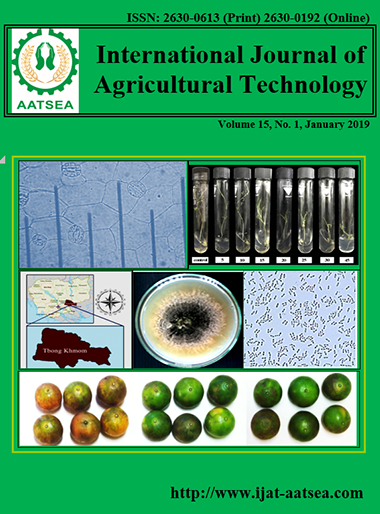Screening, identification and evaluation of potential biocontrol fungi against water lettuce
Main Article Content
Abstract
Water lettuce is a major problem in water resources and rapid widespread. The management focused to change from herbicides to biological control using natural enemies of water lettuce including fungal pathogens. The blighted and spotted leaf of diseased water lettuce plants were collected from 8 provinces of Thailand. Thirty-nine isolates of fungal pathogens were identified using morphological characteristics. They were identified as Myrothecium 5 isolates, Chaetomium 2 isolates, Aspergillus 3 isolates, Rhizopus 3 isolates, Nigrospora 6 isolates, Bipolaris 4 isolates, Curvularia 2 isolates, Epicoccum 5 isolates and Acremonium 9 isolates. The fungal Myrothecium isolates, through the morphologically identification process, were selected to study molecular data, which were derived from sequencing the internal transcribed spacer (ITS) regions of the rDNA. The result indicated that the five Myrothecium isolates could be identified as M. inundatum. Five isolates of M. inundatum were tested pathogenicity for controlling water lettuce. Fungal isolates were found to be the virulent pathogenicity on water lettuce.
Article Details

This work is licensed under a Creative Commons Attribution-NonCommercial-NoDerivatives 4.0 International License.
References
Abbas, H. K., Johnsona, B. B., Shierb, W. T., Takc, H., Jarvisc, B. B. and Boyette, C. D. (2002). Phytotoxicity and mammalian cytotoxicity of macrocyclic trichothecene mycotoxins from Myrothecium verrucaria. Phytochemistry. 9:309-313.
Banerjee, D., Strobel, G. A., Booth, E., Geary, B., Sears, J., Spakowicz, D. and Busse, S. (2010). An endophytic Myrothecium inundatum producing volatile organic compounds. Mycosphere. 1:229-240.
Barnett, H. L. and Hunter, B. B. (2006). Illustrated genera of imperfect fungi. 4th ed. Minnesota, USA: American Phytopathological Society Press.
Barreto, R. W. (1991). Studies on the pathogenic mycoflora of selectedweeds from the State of Rio de Janeiro (Brazil). (Ph.D. Thesis). University of Reading, UK.
Barreto, R. W., Evans, H. C. and Hanada, R. E. (1999). First record of Cercospora pistiae causing leaf spot of water lettuce (Pistia stratioites) in Brazil, with particular reference to weed biocontrol. Mycopathologia. 144:81-85.
Barreto, R., Charudattan, R., Pomella, A. and Hanada, R. (2000). Biological control of neotropical aquatic weeds with fungi. Crop Protection. 19:697-703.
Boyette, C. D., Hoagland, R. and Abbas, H. K. (2007). Evaluation of the bioherbicide Myrothecium verrucaria for weed control in tomato (Lycopersicon esculentum). Biocontrol Science and Technology. 17:171-178.
Chen, Y., Ran S. F., Dai, D. Q., Wang, Y., Hyde, K. D., Wu, Y. M. and Jiang Y. L. (2016). Mycosphere Essays 2. Myrothecium. Mycosphere. 7:64-80.
Cui, Y. P., Wu, B., Peng, A.T., Li, Z. L., Lin, J. F. and Song, X. B. (2018). First report of leaf
spot disease caused by Chaetomium sp. on Hevea brasiliensis in Yunnan, China. Plant Disease. 102:824-824.
Dunne, C., Delany, I., Fenton, A. and Gara, F. O. (1996). Mechanisms involved in biocontrol by microbial inoculants. Agronomie. 16:721-729.
Felsenstein, J. (1985). Confidence limits on phylogenies: an approach using the bootstrap. Evolution. 39:783-791.
Fernandes, E. G., Pereira, O. L., da Silvaa, C. C., Pereira Bentoa, C. B. and de Queiroz, M. V. (2015). Diversity of endophytic fungi in Glycine max. Microbiological Research. 181:84-92.
Hoagland, R. E., Boyette, C. D., Vaughn, K. C., Teaster, N. D. and Stetina, K. (2012). Effects of Myrothecium verrucaria on ultrastructural integrity of kudzu (Pueraria montana var. lobata) and phytotoxin implications. American Journal of Plant Sciences. 3:1513-1519.
Jarvis, B. B., Avanasasivam, G. P. and Bean, G. A. (1985). Mycotoxin production from Myrothecium species. In J. Lacey, ed. Trichochecenes and Other Mycotoxins. John Wiley and Sons Ltd, New York.
Jiang, G. Z., Gao, F., Zhu, G. Y., Zhang, Y. K., Duan, B., Zhou, M., Liu, Y. X. and Cai, Z. Y. (2018). First Report of Leaf Spot Disease Caused by Chaetomium sp. on Hevea brasiliensis in Yunnan, China. Plant Disease. 102:453-453.
Okafor, U. A., Okochi, V. I., Chinedu, S. N., Ebuehi O. A. and Onygeme-Okerenta, B. M. (2010). Pectinolytic activity of wild-type filamentous fungi fermented on agro-wastes. African Journal of Microbiology Research. 4:2729-2734.
Okunowo, W. O., Gbenle, G. O., Osuntoki, A. A. and Adekunle, A. A. (2010). Production of cellulolytic and xylanolytic enzymes by a phytopathogenic Myrothecium roridum and some avirulent fungal isolates from water hyacinth. African Journal of Biotechnology. 9:1074-1078.
Okunowo, W. O., Osuntokia, A. A., Adekunlec, A. A. and Gbenle, G. O. (2013). Occurrence and effectiveness of an indigenous strain of Myrothecium roridum Tode: Fries as a bioherbicide for water hyacinth (Eichhornia crassipes) in Nigeria. Biocontrol Science and Technology. 23:1387-1401.
Mbati, G. and Neuenschwander, P. (2005). Biological control of three floating water weeds, Eichhornia crassipes, Pistia stratiotes, and Salvinia molesta in the Republic of Congo. BioControl. 50:635-645.
Piyaboon, O., Pawongrat, R., Unartngam, J., Chinawong, A. and Unartngam, A. (2016). Pathogenicity, host range and activities of a secondary metabolite and enzyme from Myrothecium roridum on water hyacinth from Thailand. Weed Biology and Management. 16:132-144.
Saitou, N. and Nei, M. (1987). The neighbor-joining method: a new method for reconstructing phylogenetc tree. Molecular Biology and Evolution. 4:406-425.
Saitoh, K., Togashi, K., Arie, T. and Teraoka, T. (2006). A simple method for a mini-preparation of fungal DNA. Journal of General Plant Pathology. 72:348-350.
Tamura, K., Peterson, D. Peterson, N., Stecher, G., Nei, M. and Kumar, S. (2001). MEGA5: molecular evolutionary genetics analysis using maximum likelihood, evolutionary distance, and maximum parsimony methods. Molecular Biology and Evolution. 28:2731-2739.
White, T. J., Bruns, T., Lee, S. J. W. T. and Taylor, J. L. (1990). Amplification and direct sequencing of fungal ribosomal RNA genes for phylogenetics. PCR protocols: a guide to methods and applications. 18:315-322.
Yang, X., Chen, S. and Zhang, R. (2014). Utilization of two invasive free-floating aquatic plants (Pistia stratiotes and Eichhornia crassipes) as sorbents for oil removal. Environmental Science and Pollution Research. 21:781-786.
Zhang, X., Xi, H., Lin, K., Liu, Z., Yu, Y., Sun, Y. and Zhao, J. (2016). Aspergillus leaf spot of field bindweed (Convolvulus arvensis L.) caused by Aspergillus niger in China. 5:1-4.


